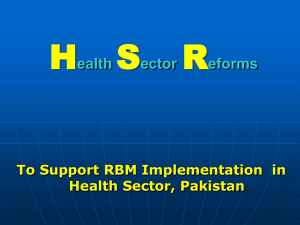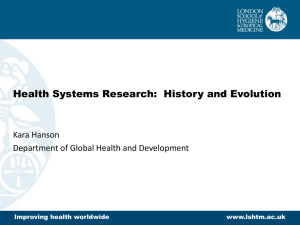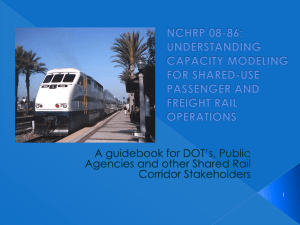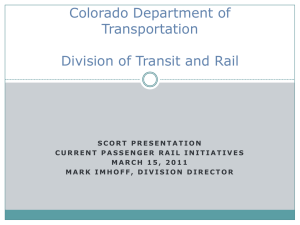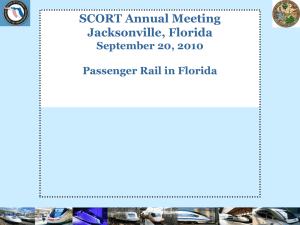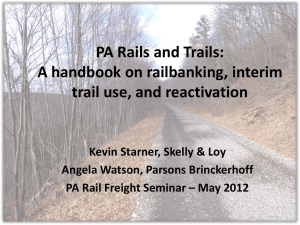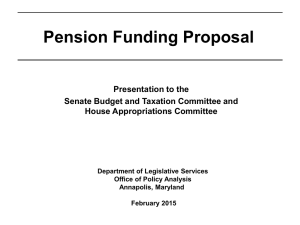high speed rail corridor (delhi-agra-lucknow-varanasi
advertisement
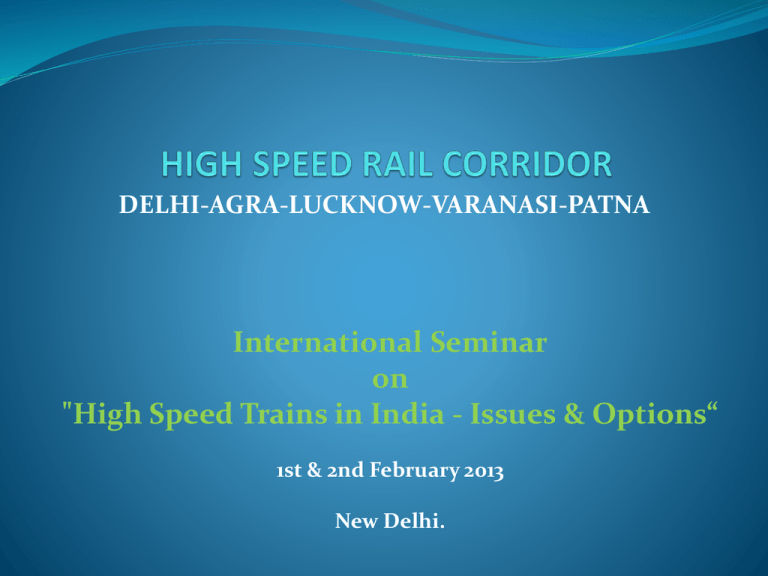
DELHI-AGRA-LUCKNOW-VARANASI-PATNA International Seminar on "High Speed Trains in India - Issues & Options“ 1st & 2nd February 2013 New Delhi. General Vision 2020 identified 6 HSR corridors for pre-feasibility study (PFS) Delhi-Agra-Lucknow-Varanasi-Patna is the longest Corridor 1000+ km long corridor passes through densely populated, Northern India’s fertile Gangetic Planes Connects Delhi with all major cities of UP and Bihar’s capital Patna; These cities are also important historical and religious tourist destinations Kanpur, Allahabad and Mathura are other major cities on the corridor GENERAL Mott Macdonald selected for PFS; Submitted report in 2011 JICA submitted a report on HSR between Delhi-Agra- Kanpur in 1987; Speed in the range of 250 kmph Project dropped in 2001 perhaps because of high cost and financial unviability Existing Transport Infrastructure The corridor generally lies on the densely saturated Delhi- Kolkata IR trunk route A separate Eastern DFC is being constructed which is expected to free additional capacities for running of passenger trains in the existing IR route All these cities are also well connected by road (NH-2 and other Highways) as well as airports Yamuna Expressway ( 6 lane road) between Delhi – Agra opened in 2012 Noida-Agra Yamuna Expressway Access Controlled, 6-lane, upgradable to 8 lane Noida-Agra Yamuna Expressway 165 KM ; Total Cost Rs 13300 Crores ( @ Rs 80 Cr/KM) 100 mts wide right of way Noida-Agra Yamuna Expressway A Greenfield airport proposed along the expressway Noida-Agra Yamuna Expressway Liberal property development rights to promoter Jaypee group A number of residential and commercial real estate projects coming up Conditions for suitability of HSR Corridor Existence of populous cities in the mid distance range of 200-800 km, having high and concentrated demand for travel High disposable income and paying capacity of the travelling public Existing transport infrastructure are saturated High GDP growth rate Other Factors Non availability of cheap, local source of oil in plenty Airports are located far from city centres Increasing environmental and sustainability concerns Why HSR International historical experience - as economy develops conventional rail (speed 110-130 kmph) unable to hold its market share Negative effects of overdependence on Roads and airways • congestion • environmental degradation, • depleting oil reserves • road accidents Why HSR More energy efficient, land efficient and environmental friendly than Roads and Airways CO2 per passenger-kilometer - HSR 30-70 grams, automobiles 150 gms and 170 grams for airplanes. A double track HSR equivalent to twice the capacity of a six lane Highway Energy efficiency – Fuel consumption of HSR – about 1/3rd of that of aircraft and 1/5th of that of private car. HSR provides more frequent, convenient, reliable service Suitability of HSR in Indian Context India has emerged as one of the fastest growing developing country during last decade; Growing middle class with disposable income Rapid urbanization Growth in demand for intercity transport specially between metropolitan areas and 2nd/3rd tier cities Inter-city car and air traffic is increasing at about 15-20% per annum in many corridors; Suitability of HSR in Indian Context Increasing congestion on roads, Delhi airports, increasing road accidents Metros like Delhi, Mumbai, Bangalore and Chennai getting choked; Need to develop 2nd /3rd tier cities Need for modal shift to energy/land efficient and environment friendly HSR/conventional Rail mode As engine of economic growth; creating jobs and facilitating other services and industries Suitability of HSR in Indian Context High population density Relatively young age profile Population growth expected to continue Maximum population in working age group (Low Dependency Ratio) A number of urban conglomerates within suitable distance range of 200-800 Km Land becoming a scarce commodity; increasing difficulty in land acquisition Increasing oil import bills to meet the growing demands from roads/airways; This is affecting India’s trade deficit and exchange rate stability. Delhi-Lucknow-Patna HSR Corridor : Favourable factor • Connects major cities of UP and Bihar with Delhi; Heavy travel demand in the corridor •The cities on the corridor are important historical and religious tourist places •Very high population density within the cities as well as catchment area •Population growth rate is higher than India average Delhi-Lucknow-Patna HSR Corridor : Favourable factor • Except for Varanasi all other cities are growing at very fast rate •Existing IR corridor, NH-2 and Delhi airport is saturated •The region is fertile plain land and people are generally well off •Plain land – so civil cost of HSR will be less •Land is a scarce commodity; resistance to land acquisition Delhi-Lucknow-Patna HSR Corridor : Unfavourable factor •Many stretch along corridor are low lying and flood prone – elevated corridor required •Except Delhi, IT and other high end service and manufacturing industries not well developed •River crossings at many locations (major rivers Ganga, Yamuna, Sone) • Eastern DFC Options for HSR in the Delhi-Agra-LucknowVaranasi-Patna Corridor Two options 1) Upgrade the existing rail corridor upto speed of 160-200 kmph, after segregation of DFC 2) To lay dedicated HSR corridor speed 300-350 KMPH Study shows that though upgrading the existing rail corridor will meet the short/medium term requirement of 5-10 years, considering overall economical rate of return, a dedicated HSR in the corridor is desirable in long term Both conventional and HSR corridor will be required to serve to different segment of customers Existing Railway stations are saturated and congested Population of major cities(2011) Population (District) Population City Delhi 16.8 16.8 Agra 4.4 1.3 Lucknow 4.6 2.2 Varanasi 3.7 1.2 Patna 5.8 1.7 Kanpur 5.4 Allahabad 5.96 2.7 Daily Traffic Volume (AC/premium class only) (2011) Delhi Agra Lucknow Varanasi Patna Total Car - 3700 550 480 360 17300 Rail(AC) - 560 2200 850 1500 11000 Air - 10 1800 500 750 7000 Bus(AC) - 400 200 Total 37500 2200 37500 2010-11 2019-20 2044-45 Daily Annual Daily Annual Daily Annual Car 17350 6.3 37200 13.6 157800 57.6 Rail(AC) 11000 4 31800 11.6 242400 7.188.5 Air 7000 2.6 19300 7.1 131700 48.1 Bus(AC) 2200 0.8 4800 1.7 20300 7.4 Total 37500 13.7 93100 34 552200 201.6 Forecast HSR daily passenger demand in 2020 (Trips per day) Forcast HSR daily paasenger demand in 2045(Trips per day) Route Alignment Delhi to Agra Option 1 - Follows the existing rail corridor to Mathura and Agra. Option 2 - Initially follows the existing rail corridor to Faridabad before using a direct (straight line) route to Agra. Option 3 - Follows the newly constructed Yamuna Express Way from Greater Noida to Agra Option 4– Starting at Indira Ghandi Airport, follows a corridor to the west of Dehli Option 5– Follows the existing rail corridor via Aligarh. Route Alignment Agra to Lucknow Option 1 - Follows the existing rail corridor via Kanpur to Lucknow and connects to an intermediate station at Kanpur Option 2 – Follows a direct (straight line) route between Agra and Lucknow (avoiding Kanpur) Option 3 – Follows a direct route to Kanpur and continues on a direct route from Kanpur to Lucknow. Route Alignment Lucknow to Varanasi Option 1 - Follows the existing rail corridor via Sultanpur Option 2 – Follows a direct (straight line) route between Lucknow and Varanasi Option 3 – Follows a direct route to Allahabad and also a direct route between Allahabad to Varanasi. Route Alignment Varanasi to Patna Option 1 - Follows the existing rail corridor via Arrah Option 2 – Follows a direct route between Varanasi and Patna but uses the existing rail corridor east of Varanasi and also uses the existing rail corridor for the approach to Patna. Corridor Map: Distance and Time • 500 Km • 2 Hrs • 7 Hrs Delhi Agra • 190 Km • 50 minutes • 2 Hrs • 1000 Km • 4 hrs • 12 Hrs Lucknow Kanpur HSR time Ex Delhi Fastest conventional Rail Time Allahabad Varanasi • 780 Km • 3 hrs • 10 Hrs Patna Features of proposed HSR •No interoperability with existing IR network •Standard Gauge •HSR station of Delhi – At Pragati Maidan or close to Nizamuddin •Station at other locations at city outskirts Features of proposed HSR Indian market is very price sensitive; so it will become essential to keep the fares of HSR about 10-15% less than airfare HSR fare would have to kept in the range of Rs 4-5 per KM Train frequency – every 10 minutes Station dwell time 5 minutes at intermediate stations 10-30 minutes at terminating stations Technologies Civil Structure and Track •On 6 m high embankment wherever possible, at low lying and congested areas on elevated viaduct •Standard Guage Ballastless or Slab track track •Track seperation 5.3 mts •UIC 60 (CEN 60) rail •swing nose crossings turnouts that can be operated at 230km/h on the diverted track. •Horizontal Curves Radius > 6000 mts Technologies Rolling Stock Max operating speed 300 kmph (Design Speed – 350) 8/16 car distributed trainset, (energy efficient, reduced energy and weight/passenger, light axle load 12-16 T, HOG, regenerative braking Train length 200/400 mts Passenger Capacity – 650/1300 persons Power requirement – 8.5/17 MW per train ( 20-23 kW per Tonne or about 13-15 kW per seat) Acceleration from 0-300 Kmph – 4-5 minutes, 14-16 KM Braking from 300 – 0 Kmph - 3 Minutes, 7-8 KM Articulated/Non articulated bogie Technologies Power Supply •2 x 25kV 50hz AC auto transformer feed • TSS - Every 50km (approx), Fed from HV supplies at 220kV, 2 x 80MVA transformers at each supply point. •Autotransformer system (25-0-25kV), Autotransformers located every 10km (approx) •SCADA system provided for control Technologies Signalling and communications CBTC, In cab signalling, ETCS 2 or ETCS 3 (Moving block, high capacity; 3 to 5 min headways) Automatic train control / protection • Train detection (Axle counters) Communication – GSM-R •TETRA (Voice Communication) •Fibre Optic Transmission Network Operation • Year 2020 – Nineteen 8 car units out of which 15 in operation Train frequency every 10 minutes • Year 2045 – Forty Eight 16 car units out of which forty four in service Train frequency every 5 minutes • Depot Location at Lucknow •The terminal station in Delhi will be at Pragati Maidan. A 6platform station is recommended with additional passive provision to extend this to 8 platforms when passenger demand justifies it. The station platforms are elevated at approximately 8m above ground level and arranged as 2 island platforms and 2 side platforms. •Agra station will be at grade and located on the left of the NH-2 (Agra - Kanpur), on the right side of the Yamuna Expressway at the intersection of the YEW and NH2. A 2-platform arrangement is provided at Agra that incorporates a turn back siding. •Lucknow station will be at grade and located in proximity to Lucknow Airport along the east part of the National Highway 25 (Lucknow - Kanpur). A 4-platform arrangement is provided which also incorporates a turn back facility. •Allahabad station will be at grade and located adjacent to the existing Phaphamau railway station just east of the NH93. A 2platform station is recommended at Phapaphamu. •Varanasi station will be at grade and located in the southern outskirts of the city in proximity to Delhi Public School along State Highway98 near its intersection with SH 74. A 2-platform station arrangement is recommended at Varanasi, incorporating a turn back siding. •Patna station will be at grade and located at the site of the Airport (which will be vacated) in close proximity of Phulwari Sharif railway station. A 4 platform terminal station is recommended. Finance Cost – Rs 100 to 110 Crs per Route KM with land acquisition - Rs 80-85 Crs per route Km without land acquisition Unit Cost •Embankment •Elevated Viaduct •Bridge •Tunnel •Trainset ( 8 car) – Rs 10 Cr/Km - Rs 50/KM - Rs 500/Km - Rs 600/Km – Rs 220 Cr O&M Cost Rs 0.5 per passenger KM (other than rolling stock) Economic Rate of Return – 18-21% Financial Rate of Return - 10-12% Conclusion •Upgrading of existing IR Delhi-Kolkata line may work for short/medium term of 10 yrs •In long term dedicated HSR is essential for the corridor •The HSR should be on standard gauge •Mobilizing huge initial capital investment will be a big challenge. PPP route is suggested. Still Govt will have to provide for VGF and counter guarantee for Loan •To attract private players PPP framework should allocate risk judiciously. Conclusion •Adequate provision for non farebox revenue by way of property development and rentals to keep the ticket price competitive •HSR should come up as part of overall development package including land-use, integrated transport. State government would have to play active part. •Associated benefits of HSR along with increased tax revenue to Govt would pay off for the initial capital investment. Thank You The TGV at 574 km/h in 2007 France has over 1500 km of HSR route serving 9 major cities Germany has 4 HSR routes covering almost 900 km with 3 further routes planned TGV, France ICE, Germany Overseas HSR Spain has several HSR routes open or under construction totalling over 1000 km Alaris, Spain Japan opened the world’s first HSR in 1964, the Tokyo to Osaka Shinkansen, which has since been expanded (now over 2400 km) ShinkansenJ apan Case study of Japan HSR System Rolling Stock: Shinkansen N700 Dedicated route, Standard UIC track gauge (1,435mm) Structure: mainly elevated Broad car body gauge (# 3.38m, 3+2 seats), non articulated Configuration: 16-car unit, 402m long, 970 t Capacity: 1,323 seats Power: AC 25kV, 17.08 MW, distributed traction Operation speed: 300km/h Case study of French HSR System Rolling Stock: TGV Duplex Dedicated/conventional routes, Standard UIC track gauge Structure: mainly at grade, elevated UIC car body gauge (# 2.90m, 2+2 seats), articulated Configuration: 8-car unit, 200m long, 380 t Capacity: 545 seats (with one bar coach), Power: AC 25kV, 9.8 MW, 2 power cars Operation speed: 300km/h Case study of Chinese HSR System Rolling Stock: CRH 380BL Dedicated/conventional routes, Standard UIC track gauge Broad car body gauge (# 3.27m, 3+2 seats), non articulated Configuration: 16-car unit, 400m long, # 920 t Capacity: 1,043 seats Power: AC 25kV, 18.4 MW, distributed traction Operation speed: 350km/h recently reduced to 300km/h or less Based on German technology (Siemens Velaro) Technologies Track, Civils and Power Continuously welded rail Resilient trackform (quieter) Viaducts, tunnels common Substantially straight Fairly large gradients Dedicated – no mixed train types, little or no freight 50kV autotransformer OLE Nuclear powered….in France. World Bank Study: High-Speed Rail: The FastTrack to Economic Development?, Paul Amos, Dick Bullock, and Jitendra Sondhi, July 2010 Most lines at least recover their operating and maintenance costs Difficult to recover capital costs from passenger revenues alone, but there are strong socio-economic effects: Technologies



